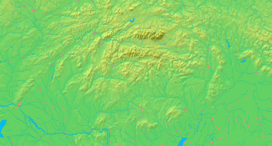Vranov nad Topľou
| Vranov nad Topľou | ||
| Town | ||
| | ||
|
||
| Country | Slovakia | |
|---|---|---|
| Region | Prešov | |
| District | Vranov nad Topľou | |
| Elevation | 132 m (433 ft) | |
| Coordinates | 48°52′51″N 21°40′24″E / 48.88083°N 21.67333°ECoordinates: 48°52′51″N 21°40′24″E / 48.88083°N 21.67333°E | |
| Area | 31.10 km2 (12.0 sq mi) | |
| Population | 23,157 (31 December 2012) | |
| Density | 745/km2 (1,930/sq mi) | |
| Mayor | Ján Ragan | |
| Timezone | CET (UTC+1) | |
| - summer (DST) | CEST (UTC+2) | |
| Postal code | 093 01 | |
| Area code | +421-57 | |
| Car plate | VT | |
  Location of Vranov nad Topľou in Slovakia | ||
  Location of Vranov nad Topľou in the Prešov Region | ||
| Wikimedia Commons: Vranov nad Topľou | ||
| Statistics: MOŠ/MIS | ||
| Website: www.vranov.sk | ||
Vranov nad Topľou (Slovak before 1927 and from 1944–1969: Vranov; German: Frö(h)nel / Vronau an der Töpl (rare); Hungarian: Varannó; Rusyn: Воронів над Топлёв) is a city of approximately 23,157 inhabitants in eastern Slovakia, situated near Košice and Prešov, and between the Topľa River and the Ondava River.
Parts: Vranov nad Topľou (proper); Čemerné
Etymology
The name is derived from a Slovak word vrana (crow) with a possesive suffix -ov. In Latin medieval record, the settlement is often called Warano (the Hungarized form), but also Wrano, Varanow or rarely Varanovia (the Latinized form).[1]
Location
Vranov nad Toplou occupies the northwest bulge of the Eastern Slovak Lowland (Východoslovenská nížina) in the upper part of the region called Zemplín between the rivers Topľa and Ondava.
History
First archaeological finds stem from the Migration Period. The earliest inhabitants of the area may have been Celtic tribes, especially the Boii which arrived in what is now Slovakia in 150-100 B.C. In about 380 A.D. the Huns arrived in what is now Hungary, and their empire flourished until 455 A.D. The Gepidi, a Celtic tribe lived in the area from 260-567 when they were conquered by the Lombards and Avars. Asian Avars arrived in the mid 6th century. Some slavs entered the area from the north but were assimilated by the Avars after 560 A.D. Ostragoths, Franks, Bulgarians also conquered the area prior to the re-arrival of the Huns 896 when they crossed the surrounding Carpathian mountains. The future town Vranov nad Topľou was uninhabited or sparsely inhabited when the Hungarian tribes arrived in the area after 896 A.D. There is no record of any major settlement in the area. The medieval settlement of Vranov nad Topľou was part of the castle estate Csisva which was built in 1310. Because of the advantageous geographical position of the town situated on the important trading path leading from Eperjes/Prešov, Vranov nad Topľou became an economic and social centre for the territory in the basin of two rivers, the Ondava and the Topľa. Besides the local trade, handicraft production has been developed here, too.
The first written mention dates back to 1332-1335. Vranov was granted town status before 1363.
The heads of the municipal government founded were the mayor and the counselors. The town was given more municipal privileges (toll right, right to store the goods, right to hold an annual market) by King Matthias Corvinus in 1461, and the town was given the right to make out written documents with a municipal seal. The figure of King Stephen was on the first original seal. The heraldic coat-of-arms in its present form has been used since 1622. The first guilds were founded here in the 16th century. The guild of Vranov shoemakers is one of the oldest guilds in the whole Zemplín county. A grammar school was founded in the town in the 16th century.
When a large part of Hungary was conquered by the Turks in 1526, Vranov was mostly unaffected as the northern regions of Hungary were not conquered by the Turks and this allowed the city to prosper under the Zapolya house which ruled the area and the Thokoly's in the late 17th century.
In the second half of the 19th century, Vranov nad Topľou became the centre of a region of 44 villages. At the end of the century there was mass emigration. In 1903, Vranov got access to the railroad; electric lighting and the telephone were introduced in 1906.
After the formation of Czechoslovakia, the Hungarian name Varanno was changed to Vranov nad Topľou and it remained a small agrarian and craft town. During the Second World War, some partisan groups were formed in the region, and the town became the centre of an anti-fascist revolt. In 1942 most of the remaining Hungarians, those who would not declare that they were ethnic Slovaks, were deported from Vranov and ethnic Slovaks were moved into the area. The period after 1945 was a time of industrial development, building of housing estates and reconstruction of the town centre.
Demographics
According to the 2001 census, the town had 22,985 inhabitants. 93.11% of inhabitants were Slovaks, 4.40% Roma, 0.61% Czechs, 0.27% Rusyns and 0.25% Ukrainian.[2] The religious makeup was 62.61% Roman Catholics, 20.13% Greek Catholics, 7.18% Lutherans and 5.70% people with no religious affiliation.[2]
Noteworthy objects
The town features a Gothic church from the 15th century (rebuilt 1578 and again 1718), a baroque monastery from 1718, a neo-Gothic Evangelic Lutheran church of 1930-1935, a Reformed church from the early 20th century, a synagogue of 1923, and a classicist manor house (a castle built in the 18th century on the place of a castle built in the Middle Ages). Vranov was also a major milling centre during the 16th century.
The town is the starting point for trips to the Veľká Domaša water reservoir.
The town is an economic center of the surroundings. In the late 20th century it housed chemical (Bukóza works), clothing (Slovenka), building materials and food industries.
Sports
MFK Vranov nad Topľou
The city has one football club, MFK Vranov nad Topľou, which competes in the Slovak Third League (East), the third-tier of Slovak football.
Famous people
- Ján Figeľ, the first European Commissioner for Slovakia, currently the leader of the Christian Democratic Movement party.
- Vladimír Kobielsky, an actor born in Vranov
International relationship
Twin towns and sister cities
Vranov nad Topľou is twinned with:[3]
 Bystřice nad Pernštejnem, Czech Republic
Bystřice nad Pernštejnem, Czech Republic Dynów, Poland
Dynów, Poland  Vynohradiv, Ukraine
Vynohradiv, Ukraine Mád, Hungary.
Mád, Hungary.
References
- ↑ "Názov mesta". The Official Website - Vranov nad Topľou. 3 November 2015. Retrieved 27 November 2016.
- 1 2 "Municipal Statistics". Statistical Office of the Slovak republic. Archived from the original on 2008-01-11. Retrieved 2008-02-03.
- ↑ "Mesto v skratke". Ciy of Vranov (in Slovak). Archived from the original on 16 November 2016. Retrieved 03 November 2015. Check date values in:
|access-date=(help)
